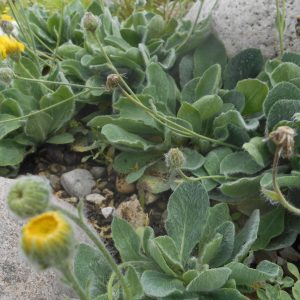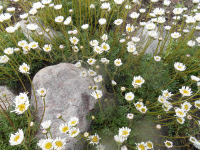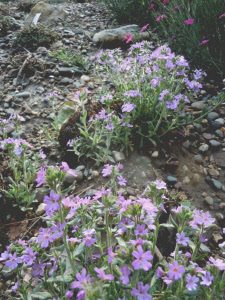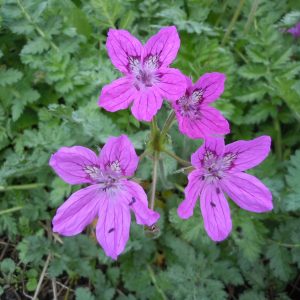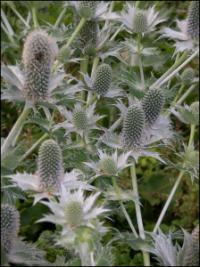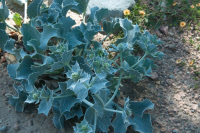Shop
Showing 289–296 of 788 results
-
Erigeron aureus Alpine yellow fleabane Z 5-8
White hairs cover frosted-looking basil leaves making this worthy of any garden even without flowers, but then its school bus yellow daisies flower from spring through fall.
OUT OF STOCK
White hairs cover frosted-looking basil leaves making this worthy of any garden even without flowers, but then its school bus yellow daisies flower from spring through fall.
Size: 3-4” x 3”
Care: sun in moist well-drained to well-drained soil
Native: Cascade Mountains from Alberta to State of Washington
Wildlife Value: attracts bees, butterflies and birds1st described in literature in 1884.
-
Erigeron compositus Cutleaf daisy, Dwarf mountain fleabane Z 3-8
Miniature, cushion shaped plant with wooly grey leaves topped by small bluish, pink or white rays like a daisy with a yellow center. Flowers in June-July.
Miniature, cushion shaped plant with wooly grey leaves topped by small bluish, pink or white rays like a daisy with a yellow center. Flowers in June-July.
Size: 6” x 6-12”
Care: sun to part shade in well-drained soil.
Native: all of western No. America from prairies to alpine slopes.Erigeron comes from Greek er meaning “spring” and geron for “old man” due to some of these species having white downy hair like an old man.
Thompson Indians from British Columbia chewed on the plant then spit on sores to remedy skin ailments. They also made a decoction of the plant, mixed with any weeds for broken bones. Collected by Meriwether Lewis in late spring 1806 near today’s Lewiston Idaho. Erigeron comes from Greek er meaning “spring” and geron for “old man” due to some of these species having white downy hair like an old man. -
Erinus alpinus Fairy foxglove, Alpine balsam Z 4-7
May- July violet, pink or white 5-petaled stars, self-sows
OUT OF STOCK
May- July violet, pink or white 5-petaled stars, self-sows
Size: 3” x 4” spreads
Care: sun to part shade in well drained soil
Native: Alps & Pyrenees
Awards: Royal Horticultural Society Award of Garden Merit.Erinus comes from Greek er meaning spring, for the time when this plant blooms. Collected by 1716. Wm. Robinson, father of mixed perennial border, called this a “pretty alpine plant.”
-
Erodium manescavii syn. Erodium manescani Heron’s bill Z. 5-8
Magenta saucer-shaped petals April-November. Seed’s tail like a corkscrew, flings seed as it dries.
Magenta saucer-shaped petals April-November. Seed’s tail like a corkscrew, flings seed as it dries.
Size: 12-18” x 8”
Care: Full sun in well-drained soil
Native: PyreneesErodium is Greek meaning “heron,” because the seed capsule resembles a heron’s head and bill. Collected before 1889. According to William Robinson, father of the mixed perennial border, this is “most showy (and) throws up strong flower stalks…each with 7 to 15 purplish flowers.”
-
Eryngium amethystinum Amethyst sea holly Z. 3-8
Metallic amethyst stems, spiny bracts and cone-shaped flower in July and August
ARCHIVED
Note: This is a plant not currently for sale. This is an archive page preserved for informational use.
Metallic amethyst stems, spiny bracts and cone-shaped flower in July and August
Size: 28” x 28”
Care: Full sun in well-drained soil, drought tolerant
Native: Italy & southern Alps
Wildlife Value: attracts bees & butterflies, birds eat seeds. Deer & rabbit resistant
Awards: Great Plant Pick Award from Elizabeth Carey Miller Botanical Garden.Garden cultivation since 1648. Long prized for its metallic luster.
-
Eryngium giganteum Miss Wilmott’s ghost SELF-SEEDING BIENNIAL Z 5-8
In summer, oval thistles top prickly green, turning steely blue, silvery, bracts – very ornamental.
In summer, oval thistles top prickly green, turning steely blue, silvery, bracts – very ornamental.
Size: 36" x 24"
Care: Full sun in moist well-drained, fertile soil. Be sure to let it drop its seeds & do not weed seedlings out the following spring.
Native: Caucasus Mountains
Awards: England's Royal Horticultural Society Award of Merit.Eryngium is Greek for thistle. This species introduced to England in 1820. Miss Ellen Willmott (1858-1934), a wealthy, expert, eccentric English gardener reputedly dropped seeds as she passed her neighbors’ gardens. The plants came up afterwards, her “ghosts.” Recommended by Gertrude Jekyll in 1908.
-
Eryngium maritimum Sea holly Z 5-10
Round thistles turning steely blue in July-August atop silver colored, prickly bracts. Attractive ivy-shaped prickly foliage.
OUT OF STOCK
Round thistles turning steely blue in July-August atop silver colored, prickly bracts. Attractive ivy-shaped prickly foliage.
Size: 12" x 10" slowly spreads
Care: Full sun in well-drained soil.
Native: Seacoasts of Europe“Eryngium” is Greek for thistle. Anglo-Saxons prescribed Sea holly root to cure the king’s evil, serpent bites, broken bones, stiff necks and melancholy. Also considered an aphrodisiac and brought on “kissing comfits.” This was identified by Dioscorides in De Materica Medica for medicinal use around 70 A.D. Eryngium was described in Gerard’s Herball in 1597 for its uses:” old and aged people that are consumed and withered with age, and which want natural moisture (and also) amended the defects of nature in the younger,” William Robinson, father of the mixed perennial border, considered this plant “very pretty.”
-
Eryngium planum Flat sea holly Z 5-9
Round thistles top prickly steel blue, silver colored, bracts June-August. Stems turn steel blue too. Deadhead for repeat bloom. Reseeds readily. Great cut flowers: dry or fresh…
Round thistles top prickly steel blue, silver colored, bracts June-August. Stems turn steel blue too. Deadhead for repeat bloom. Reseeds readily. Great cut flowers: dry or fresh.
Size: 36” x 18”
Care: Sun well-drained soil, drought tolerant
Native: E. EuropeEryngium is Greek meaning “thistle.” Described in Gerard’s Herball in 1597 for its uses to remedy: “old and aged people that are consumed and withered with age, and which want natural moisture (and also) amended the defects of nature in the younger.”

